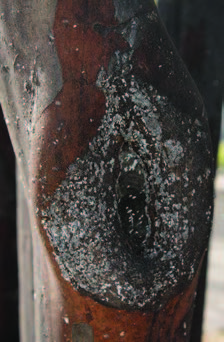Crape Myrtle Bark Scale

Searcy, Ark. - A relatively new insect is appearing on crapemyrtles (Lagerstroemia) across the Southeast, including Arkansas. Although the exact taxonomy is still not known, the insect is most commonly referred to as crapemyrtle bark scale (CMBS).
Since the initial sighting in 2004, the insect has been spreading at an alarming rate across the Southeast. The insect was first noted in McKinney, Texas (self-designated as America’s “crapemyrtle city”), in 2005 and had spread throughout most of the Dallas-Fort Worth area by 2010. The scale was reported in Ardmore, Okla., and Shreveport, La., in 2012 and Houma, La. (60 miles southwest of New Orleans) in 2013. In October 2013, the insect was confirmed in Germantown, Tenn. (Memphis area), and in Little Rock, Ark., in January 2014.
Heightened concern about this new pest is based on the speed at which it is spreading and the common use of crapemyrtles in landscapes across a large part of the U.S. To date there has been no research to evaluate whether there is a range in susceptibility to this insect across the hundreds of crapemyrtle cultivars; however, ancecdotal observations from McKinney, Texas, suggest the scale may be worse on hybrids (fauriei × indica).
Insect Description
Crapemyrtle bark scale is easy to identify since, in the U.S., it is the first and only known bark scale to occur on crapemyrtles. The adult females appear as white or gray felt-like encrustations on small twigs to large trunks, often appearing near pruning wounds or in branch crotches on older wood. On the most current flush of growth and under heavy infestation, distribution may be more uniform. Up close, CMBS is white to gray in color and approximately 2 mm in length. Careful examination may reveal dozens of pink eggs or crawlers under some of the larger white scale covers. Most gardeners will be alerted to CMBS by black sooty mold which appears on the bark. The presence of sooty mold may confuse the diagnosis since that is also commonly associated with a significant aphid problem. This felt scale is not classified as either an armored or soft scale.
Life Cycle
As female nymphs mature, they secrete white threads that become felted or matted into a thick, whitish to grayish scale covering over the entire body. Adult females under this covering are wingless and sessile (attached and incapable of moving). It is thought that for this species of scale, eggs are laid under the covering (probably late April to mid-May in Arkansas) and the female then dies. When the eggs hatch into first instar nymphs, these nymphs have legs and antenna and are mobile, thus the term crawlers. These crawlers emerge from under the “‘mother scale” and disperse over a short period (about one to two days). We suspect that this emergence occurs beginning mid-May to early June in Arkansas; however, crawlers were observed on a warm day in January 2014. After the first molt, nymphs lose their legs and antenna and become sessile. During the last instar, males are quiescent (pupal type stage) and develop external wings. Upon emergence, males find a sessile female and mate, completing the life cycle. At present in the Southern U.S., the number of generations completed in a year for this species is unknown, but it is suspected that CMBS may complete at least two generations in Arkansas. It is possible that adult females and eggs overwinter, but crawlers and later stage nymphs have been observed overwintering in Arkansas under loose bark and in cracks and crevices.
Control
Based on our limited experience with this pest, it does not appear that CMBS will be easy to control, though soil-applied neonicotinoids do provide significant suppression. Our current best suggestions for control of this insect include:
- For heavily infested plants, wash the trunk and reachable limbs with a soft brush
and mild solution of dishwashing soap. This will remove many of the female scales
and egg masses and make insecticide control more effective. Also, washing will remove
much of the black mold that builds up on the bark on infested trees.
- Horticultural oil has not yet been shown to be effective against this insect; however, a winter application of dormant oil to the bark and crotches of the plants where scales shelter may be beneficial. Be sure to use sufficient volume to allow for penetration behind loose bark and into cracks and crevices. Winter is an especially good time to treat for scales because a higher (winter) application rate can be used without damaging the plant. Thorough coverage of the tree is especially important when treating with oil.
• Application of systemic insecticides as a drench applied to the root zone has shown the most promise in tests to date. Imidacloprid (Merit® or Bayer Advanced™ Garden Tree and Shrub Insect Control), thiomethoxam (Meridian®) and dinotefuran (Greenlight Tree and Shrub Insect Control with Safari) have shown best control when applied between May and July. When drenching the soil with a systemic insecticide, allow several weeks for the product to be distributed throughout the plant. Additionally, acetamiprid and clothianidin, also neonicotinoids, have demonstrated good control.
By Sherri Sanders
County Extension Agent - Agriculture
The Cooperative Extension Service
U of A System Division of Agriculture
Media Contact: Sherri Sanders
County Extension Agent - Agriculture
U of A Division of Agriculture
Cooperative Extension Service
2400 Old Searcy Landing Road, Searcy AR 72143
(501) 268-5394
ssanders@uada.edu
Related Links